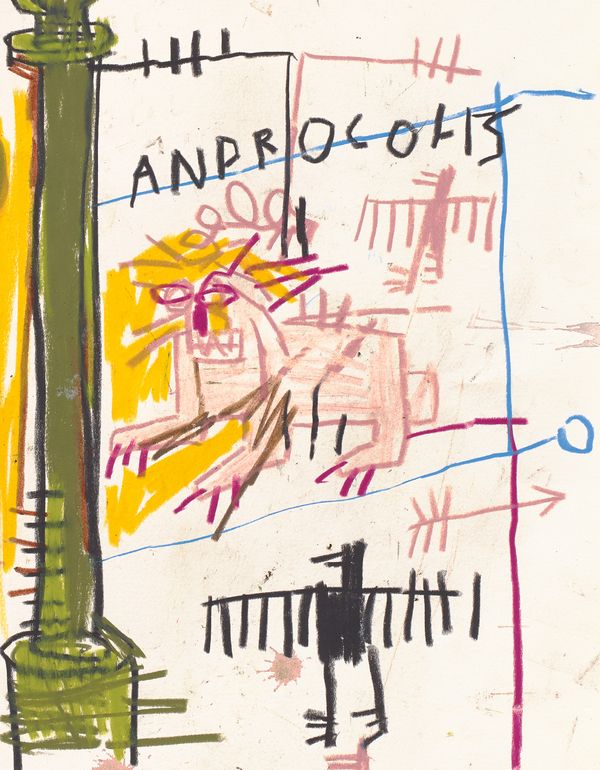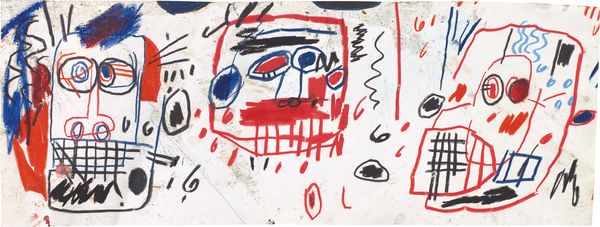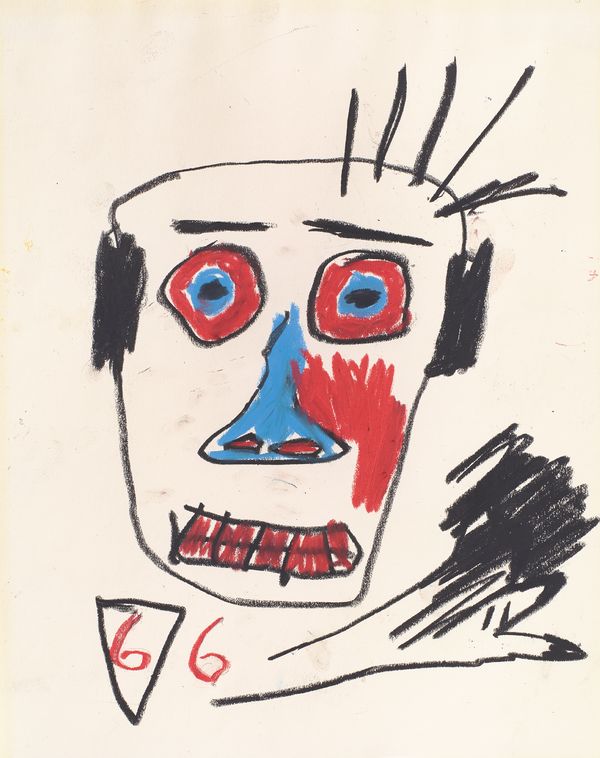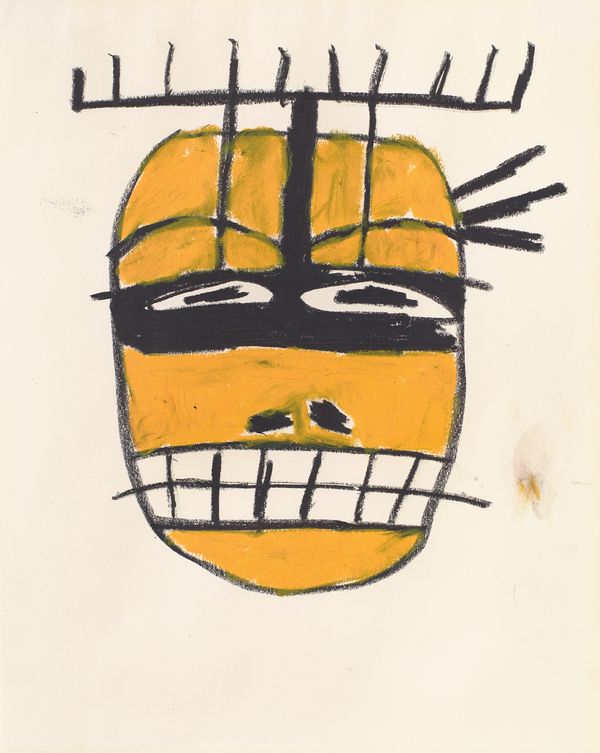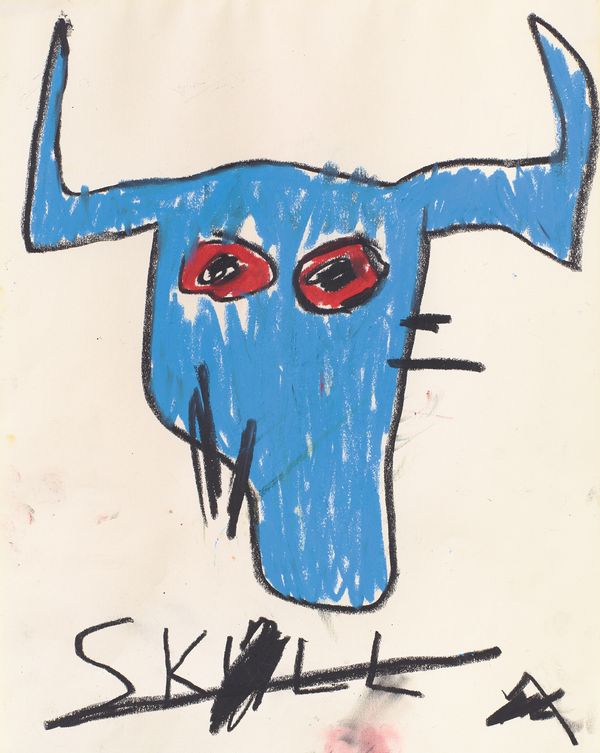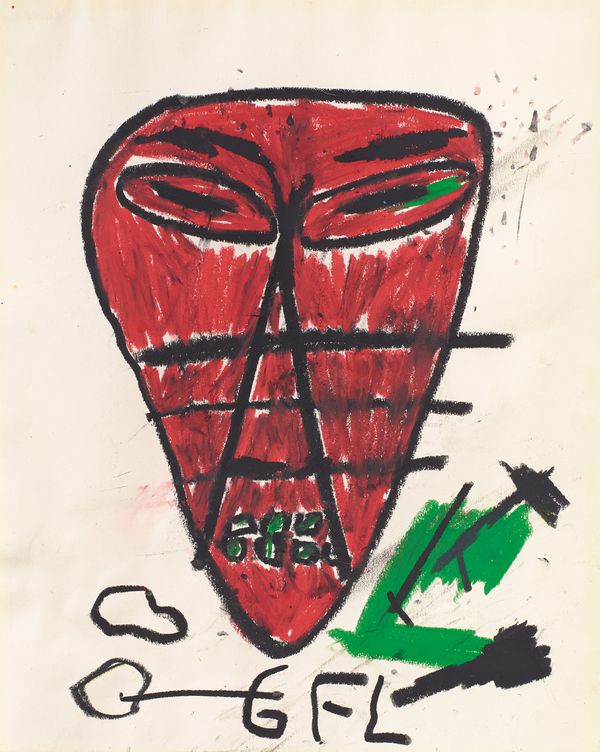Jean-Michel Basquiat, ST. MORITZ, SWITZERLAND—1983: Artist Jean-Michel paints in 1983 in St. Moritz, Switzerland. (Photo by Lee Jafe/Getty Images), artwork © The Estate of Jean-Michel Basquiat/ADAGP, Paris /ARS, New York.
I don't think about art when I'm working. I think about life.
—Jean-Michel Basquiat
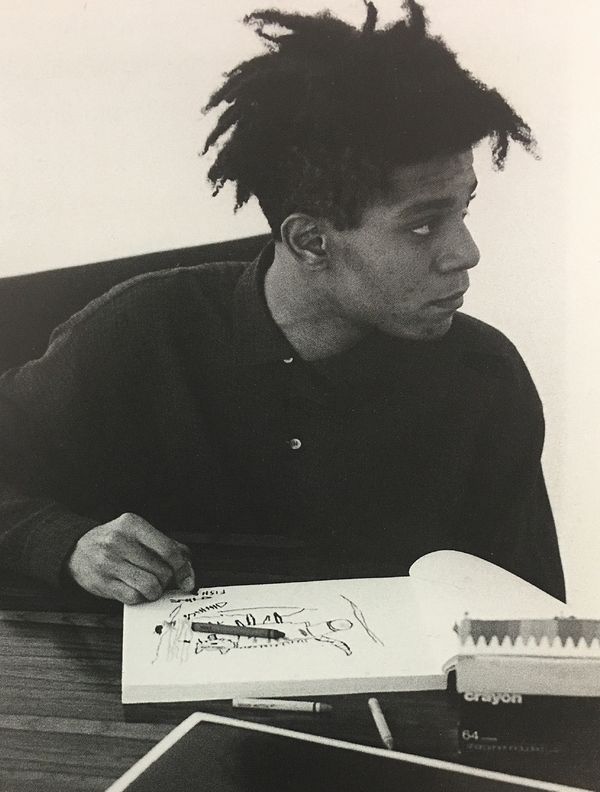
Jean-Michel Basquiat photographed at the Akira Ikeda Gallery, Toyko, on November 9, 1985. Photographed by Yoshitaka Uchida.
Introduction
Basquiat was a drawer; he drew to release from his mind his dynamic texts, shapes and symbols in a deluge of artistic spontaneity onto paper. His creative imagination led him to frequently reuse and re-imagine graphic symbols, turning them into striking visual combinations, scattered with poetic snippets, resulting in an elegant, artistic vocabulary that was all his own. For Basquiat, the draftsmanship of drawing was never a means of studying or preparation but an artistic practice in its own right.
This May in New York, Phillips proudly presents six works on paper by Jean-Michel Basquiat from the Collection of Scott D.F. Spiegel, an esteemed Los Angeles art collector whose cutting-edge acquisitions of 1980s artwork and commitment to emerging art is demonstrated by the multitude of works purchased for the Museum of Contemporary Art, Los Angeles through the Scott D. F. Spiegel Endowment Fund. These six works represent the best of Basquiat's works on paper which stand within the artist's practice as his most pure of creations.
The Collector

"Culture Custodian, Collector Scott Spiegel has an eye for cutting-edge art," Art & Auction, March 1990. Photographed by James Franklin.
[Spiegel] was the youngest amidst a group of Hollywood executives passionately dedicated to 'the art of the new' in the early 1980s.
Scott Spiegel began collecting at the age of 17 when, as a high school student, he found his way to the most prominent galleries in New York in pursuit of undiscovered gems by Jasper Johns, Roy Lichtenstein and Andy Warhol. A few years later while attending Georgetown University in Washington D.C., where he studied art history, Scott began developing relationships with young New York artists such as Peter Reginato, Troy Brauntuch, David Salle and Robert Longo.
After graduating from Georgetown Law School in 1979, Scott decided to move to Los Angeles to pursue a career in the entertainment field. He was the youngest amidst a group of Hollywood executives passionately dedicated to "the art of the new" in the early 1980s. He came to the entertainment industry to work for Norman Lear and Bud Yorkin; and after this sojourn became a leading TV executive at ABC Television. Scott quickly bonded with other Hollywood collectors passionate about contemporary art, including Douglas S. Cramer, Dan Melnick, Barry Lowen, Jake Bloom, Alan Hergott and Bud Yorkin. Scott always credited Barry Lowen as the collector who truly shaped his vision:
"Barry was like an older brother to me. He was the most interesting, most aggressive and most attentive contemporary collector in L.A. He had a remarkable feel for the importance of new work. Validation of his intuitions would come years later when everyone would be after this artist. But Barry had already made a commitment to the artist regardless of what the public’s reaction was."
Scott learned from Barry Lowen to trust his intuition when confronting the art of the new. This served him well, as Scott was able to seek out and identify many of the artists who are now the acclaimed masters of their generation. I witnessed Scott's instincts as a collector many times, through our various studio visits including our first visit to the studio of Mike Kelley in 1982 where Scott immediately bonded with Mike and keenly selected several pieces to acquire. That day Scott became one of Mike's earliest collectors. Not only did Scott and I share our belief in the vision of this newly emerging talent, but from that day forward, and for the next ten years, we religiously shared our passion for a new spirit in art.
When Scott began collecting the art of the '80s, the work presented at two leading art galleries helped to shape his vision. From the outset of the opening of the Larry Gagosian Gallery on Almont Dr. in West Hollywood in 1981, Scott developed a close association with Larry Gagosian. Scott closely followed the gallery's early program, including exhibitions by Salle, Basquiat and Cindy Sherman. One of Scott's early acquisitions was Basquiat's monumental painting Six Crimee, 1982. This work, one of the defining pieces in Basquiat's oeuvre, is now in the collection of The Museum of Contemporary Art, Los Angeles: The Scott D. F. Spiegel Collection.

Interior view, six works on paper by Jean-Michel Basquiat. Photograph by Douglas M. Parker, art © The Estate of Jean-Michel Basquiat/ADAGP, Paris/ARS, New York 2017
Scott met Basquiat during the installation of the artist's first exhibition at The Larry Gagosian Gallery in West Hollywood in April 1982. Scott visited Basquiat several times during his initial stay in Los Angeles and subsequently visited the artist in his studio in New York later that same year. They again hung out, both at Scott’s apartment in West Hollywood and in Basquiat’s Venice studio when the artist returned to Los Angeles in November to paint his second exhibition for the gallery. The following six works on paper by Basquiat were acquired directly from the artist both in Los Angeles and in New York in 1982. At this time Scott was one of only five collectors who had acquired multiple works by Jean-Michel Basquiat, highlighting his prescient instincts as a collector.
Not only did Scott collect for himself, he equally provided critical advice and encouragement to many other Hollywood collectors, including Barry Lowen and Douglas S. Cramer, both of whom became aware of Basquiat through their junior colleague. Barry Lowen later donated a major Basquiat painting to The Los Angeles Museum of Contemporary Art and Douglas S. Cramer to The Whitney Museum of American Art.
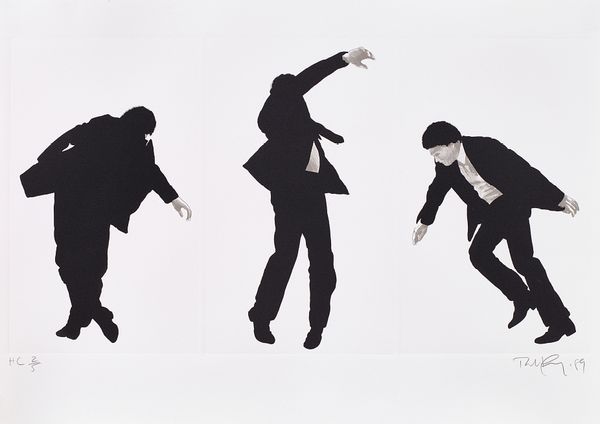
Robert Longo Scott, 1989. Lithograph, Edition HC 2/5. © 2017 Robert Longo/Artists Rights Society (ARS), New York.
...Whenever I see the Hollywood sign, I think of Scott.
— Robert Longo
Scott also closely aligned himself with members of "The Pictures Generation," especially those artists exhibiting at Metro Pictures in New York. Scott was one of the early supporters of Cindy Sherman, Robert Longo and Laurie Simmons. He became especially close with Robert Longo, not only collecting his work, but also bringing Robert to the attention of other Hollywood collectors; and even facilitating Robert's introduction to Hollywood as a film director. A record of their friendship is visually memorialized in Robert Longo's three-part work entitled Scott.
As Robert Longo reminiscences, "I met Scott in the early 1980s. I was a young artist, and he was incredibly supportive and nurturing. Scott was enthusiastic about my work—he was an early collector of my 'Men in the Cities' drawings, which he had in his West Hollywood home. In 1983 when I was planning my solo show with Larry Gagosian in Los Angeles, Scott let me stay at his apartment. I had his place to myself; it was incredible.I slept under Scott's Basquiat painting, Six Crimee. Funnily enough, I was most excited about Scott's color television with its remote control. I had never had one. I remember waking up in the morning, with the fresh air and the Los Angeles sunshine coming through the windows. Whenever I see the Hollywood sign, I think of Scott."
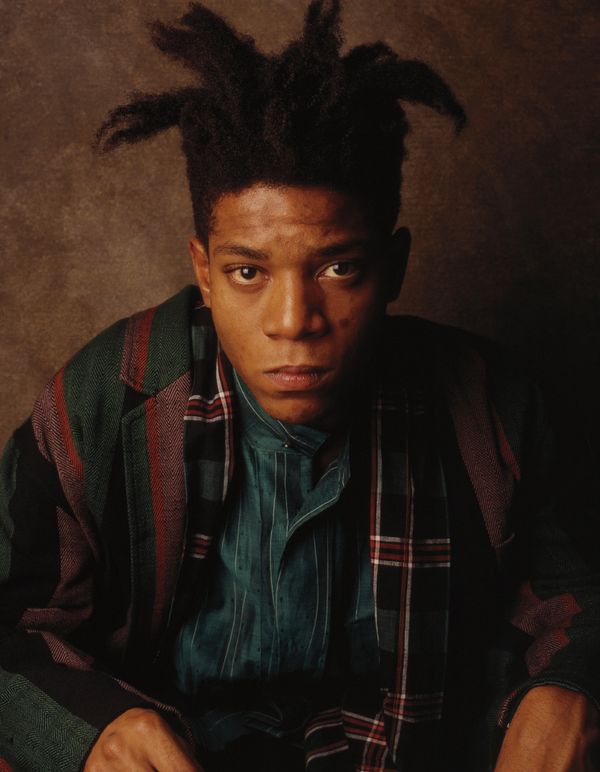
Jean-Michel Basquiat, New York, 1987. Photographed by William Coupon © 2017 William Coupon.
A testament to both Scott's vision as a collector as well as his defining role in the art of the early 1980s is his formation of the The Scott D.F. Spiegel Collection at The Museum of Contemporary Art, Los Angeles. Including works by Basquiat, Salle, Longo, Susan Rothenberg, Mark Innerst and many others, Scott's donation to MOCA, alongside those of Barry Lowen, Phil and Bea Gersh, Bob Half and others, helped to create one of the most definitive collections of 1980s art. Scott's commitment to MOCA also took on another important dimension; he had long expressed his desire to create a permanent fund that would enable the museum to regularly acquire new works by young and emerging artists for its collection. Scott's bequest to initiate The Scott D. F. Spiegel Purchase Endowment for MOCA made this dream a reality. As Richard Koshalek, the former Director of The Museum of Contemporary Art, Los Angeles noted, "Scott's goals for his collection and endowment closely matched MOCA's own mission to encourage and cultivate the making of art, the exchange of ideas and the enhancement of artistic and cultural experience for a broad public."
Scott's dedication to contemporary art is particularly evident by his 1982 acquisition of the following six works on paper directly from Jean-Michel Basquiat. Scott's commitment to the art of the new is equally evidenced in the Collection and Endowment established by Scott's bequest which stands as an enduring legacy of a unique — and far too brief — life, marked by a passionate love of contemporary art and culture.
The Works
From the Evening Sale: Jean-Michel Basquiat Untitled. Oil paintstick on paper, executed in 1982.
Untitled, 1982 is a rare work in the oeuvre of Jean-Michel Basquiat. It brings forth, within a work on paper themes and subjects found in key paintings including Acque Pericolose, 1981, Untitled (LA Painting), 1982, Notary, 1983, Untitled (Black Tar and Feathers), 1982, and pieces from the acclaimed Daros Suite, 1982-83, of 32 works on paper. Presenting the image of a standing black male surrounded by an array of symbolic images, this work distinguishes itself from other works on paper in its rich narrative content. The subject matter of this work is the triumph of freedom over physical adversity. In contrast to other works depicting an iconic black male figure, this work singularly tells a story — the struggle for liberation and an ultimate victory.
This work presents a full-length, armless black male depicted in the nude. Not only does the work reveal the figure's external physiognomy, it equally portrays internal organs and musculature. Unique in the oeuvre from this period, both arms are severed at the shoulder sockets. This disembodiment is suggested by "energy" lines extending away from the figure's right shoulder as well as by a symbolic lightning bolt directly below. Basquiat reinforced this representation of physical loss in the depiction of a severed foot and ankle with spikes or nails driven through the toes and ankle. The rendering of the severed foot in Untitled is depicted again in King Brand, one of the works on paper from The Daros Suite.
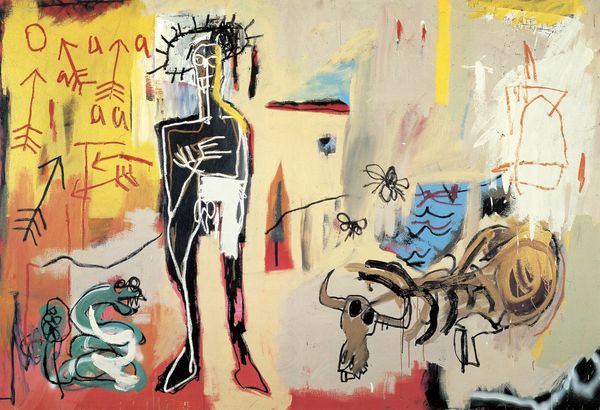
Jean-Michel Basquiat Acque Pericolose (Poison Oasis), 1981. Acrylic, oilstick and spray paint on canvas. The Schorr Family Collection, on loan to The Art Museum, Princeton University, New Jersey © The Estate of Jean-Michel Basquiat/ADAGP, Paris/ARS, New York 2017.
Untitled is the artist's first portrayal of an armless free-standing figure. This subject is rare in Basquiat's work from 1982-1983. Possibly a precursor, the full-length, standing black male in Acque Pericolose, as seen above, seems to be armless; upon more careful inspection, it is revealed that the figure's arms are, in fact portrayed by simple white lines crossing at the figure's chest. Interestingly, Acque Pericolose shares a second similarity with Untitled in the depiction alongside the standing figure of a four legged creature. While the animal portrayed in Acque Pericolose appears decimated — more of a skeleton than a living creature — the animal alongside Basquiat's figure in Untitled appears both alert and animated.
Acque Pericolose was an important precedent for Untitled. "In what may be interpreted as the artist's first major self-portrait, the artist has depicted himself as vulnerable, yet possessed with pride and authority...a sense of being at peace with himself even though he is surrounded by death and upheaval" (Fred Hoffman, "The Defining Years, Notes on Five Key Works." Basquiat, The Brooklyn Museum, 2005). In Untitled, Basquiat elaborates on these same themes of vulnerability and transcendence, further using his picture making as a means of both self-representation and the expression of a larger "world view."
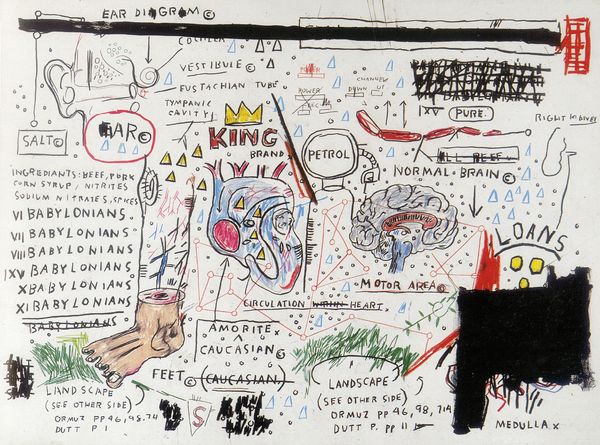
Jean-Michel Basquiat King Brand from the so-called Daros Suite, 1982-83. Acrylic, oilstick, pastel, charcoal, graphite and colored pencil on paper, Daros Collection, Zürich, Switzerland © The Estate of Jean-Michel Basquiat/ADAGP, Paris/ARS, New York 2017.
The only other renderings of an armless, free-standing figure from 1982-83 appear in Flash in Naples and Notary from 1983. In several 1984 paintings, including Pedestrian II, Freddy and Bird as Buddha, Basquiat presents the image of an armless male figure. The figure depicted in Untitled, however, remains unique as it is part of a "story" that the artist "tells" through his array of accompanying symbols and images. While the central figure of Untitled conveys physical loss, Basquiat's figure in Flash in Naples, 1983 accompanied by his animated side-kick who appears to spring through space, suggests an act of heroism. In Notary, 1983 Basquiat's central figure shares none of the attributes of loss or a diminution of physical capacity. The figure portrayed in this monumental work presents a rich iconographic portrayal of transcendence not found in the earlier Untitled. In many ways Notary, 1983 is the culmination and fullest realization of the themes and subjects first suggested in this seminal work on paper. Untitled also shares with Notary, 1983 the simultaneous depiction of external and internal components of a human figure. In both works Basquiat "x-rays" the human figure, portraying an outward focused human being who equally exposes his internal structure and make-up. Basquiat's figural portrayal in Untitled, as well as his layering of symbols and images creates a narrative content — a figure telling a story which serves as an initial exploration, a warm up for the more complex, multilayered presentations in key 1982-1983 paintings, including Untitled (Black Tar and Feathers), 1982, Portrait of the Artist as a Young Derelict, 1982 and The Nile, 1983. These paintings substantially defined Basquiat as an artist.
Central to Basquiat's practice was the representation within the same work of seemingly disparate and conflicting aspects of human experience. Whether it was the idea of reversing black into white or white into black, the scales of justice, or the theme of "God and Law," the artist was continually concerned with the representation of a duality, and the integration and reconciliation of seemingly opposing forces. In Untitled Basquiat's duality is the representation of an armless figure alongside a tall classical column, on top of which he has placed an eagle with open wings. Emphasizing the importance of this bird, he has included three additional birds all represented with spread open wings. These images link this work on paper to the monumental painting Untitled (LA Painting) executed a few months earlier in 1982. Basquiat's birds symbolize perspicacity, courage, freedom and immortality. They are his messengers from the highest Gods. In classical Roman culture the image or object of an open-winged bird was a symbol of power and strength.

Jean-Michel Basquiat Notary, 1983. Acrylic, oilstick and paper collage on canvas mounted on wood supports, triptych. The Schorr Family Collection, on loan to The Art Museum, Princeton University, New Jersey © The Estate of Jean- Michel Basquiat/ADAGP, Paris/ARS, New York 2017.
Basquiat has placed his central eagle atop a column positioned slightly behind his frontal facing, armless figure. The juxtaposition of eagle and column also has its roots in classical Rome. Erected in 113 AD, Trajan's Column commemorates the Roman emperor Trajan's victory in the Dacian Wars and stands as a monument symbolic of victory with an open-winged bird positioned atop a fluted column. As with the classical iconography, Basquiat's winged creature on top of a column also alludes to triumph and victory, while his human figure depicts physical loss and suggests vulnerability, its juxtaposition with his eagle and column implies that weakness or loss have been dealt with and overcome. Basquiat's work, in high probability represents a self-reflection at a critical juncture in his personal as well as professional life. This work is his declaration of societal as well as personal triumph over adversity — transcendence from bondage into freedom.
From the Evening Sale: Jean-Michel Basquiat Untitled (detail). Oil paintstick on paper, executed in 1982.
This conclusion is reinforced by the inclusion of a resting four-legged creature above which Basquiat scrawled the word "Androcolis," in reference to the tale Androcles and the Lion written by the Greek storyteller, Aesop, in which Androcles, a slave was saved by the requiting mercy of a lion which can be compactly moralized into the statement: "Gratitude is the sign of noble souls." Basquiat refers to the story of Androcoles and the Lion as an additional level of context to his works' primary theme of transcendence of physical and psychological adversity. Neither the word "Androcolis" nor a crouching lion are found in any other works by the artist.
As noted, Basquiat had previously turned to a similar pictorial strategy of juxtaposing figure and animal in the representation of a half alive, half skeleton cow alongside a reverential standing black male figure in Acque Pericolose. In Untitled, Basquiat relegates his lion to a "supporting" role. Much like the multi-positioned open-winged birds symbolizing liberation and transcendence, Basquiat's lion functions symbolically and does not imply a narrative interaction with his standing figure. In other words, Basquiat's figure is not Androcoles and the artist is not representing the popular tale. Having initiated his work by presenting an armless figure and accompanying "victory column," the young Basquiat was drawn to the popular tale of the prisoner and lion as his means of enhancing the subject matter of his work. In this popular tale, the ever perceptive, always discovering young artist found a message compatible with his own personal vision as a young black man attempting to overcome adversity and assert his identity.
From the Evening Sale: Jean-Michel Basquiat Untitled (Three Heads). Oil paintstick on paper, executed in 1982.
In Untitled (Three Heads), 1982, Basquiat presents a portrait gallery of three personages, each individualized and highly expressive. Rendered from only three oil paintstick colors—red, black and blue—Basquiat's goal was to simultaneously characterize and animate each figure. The head to the left presents the viewer with large peering eyes, gazing directly at the viewer, nostrils flaring wide open, mouth bearing a full set of teeth, hair spiking up and out in a multiplicity of directions. This is the most completely rendered of the three heads, not only establishing the level of energy for the overall work, but the primary means by which the viewer is "invited" into the world of Basquiat's characters. The somewhat diminutive size of the middle head causes it to slightly recede back from the more formidable head to its left. While this figures' eyes are piercing, both nose and mouth present a less detailed rendering. This character feels more inwardly focused. Basquiat's third head does not peer out towards the viewer. Rather, this figure is depicted in profile, with its focus directed at the other two heads. The most simplified of the three, this figure serves an important purpose of conveying that the three personages are engaged with each other. Basquiat's heads are neither symbols nor icons. They are the representation of "real" people, full of the capacity to both emote and interact.
Untitled (Three Heads) is an important work in the oeuvre of Jean-Michel Basquiat; it is one of the only works on paper in which the artist has depicted multiple images of intensely focused, highly energized figural heads simultaneously asserting their presence as they stare out toward the viewer. The only other works on paper representing multiple heads are two earlier drawings depicting "Famous Negro Athletes" — one with three heads, the other with four. While the idea of capturing multiple heads in the same work may have come from these two earlier works, the heads portrayed in Untitled (Three Heads) are now highly expressive, revealing a significant shift of focus within Basquiat's concern for both the physical and psychological presence of his subjects. Coming less than a year after "Famous Negro Athletes," Untitled (Three Heads) is one of the earliest examples of a newly evolved subject matter.
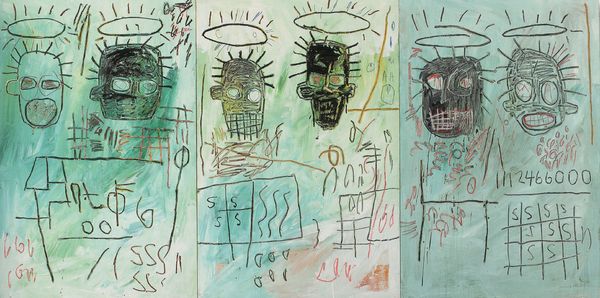
Jean-Michel Basquiat Six Crimee, 1982. Acrylic and oil paintstick on masonite. The Scott D. F. Spiegel Collection, The Museum of Contemporary Art, Los Angeles © The Estate of Jean- Michel Basquiat/ADAGP, Paris/ARS, New York 2017.
Scott Speigel acquired Untitled (Three Heads) at the same time as the monumental Six Crimee from the artist's first exhibition at the Larry Gagosian Gallery (April 8-May 8, 1982). The ambitious new collector met Basquiat during the young painter's initial visit to Los Angeles for his opening at the Larry Gagosian Gallery, accompanied by members of his "crew" Ramelzee and Toxic. Their visit to Los Angeles is memorialized in the wonderful painting Hollywood Africans now at the Whitney Museum of American Art in New York. Scott continued to stay in touch with Jean-Michel Basquiat, visiting him in his New York studio and regularly seeing him in Los Angeles later that same year, at which time Basquiat both worked and resided in the ground floor of Larry Gagosian's townhouse in Venice. Six Crimee is the depiction of six black heads, each highly individualized and expressive, each topped by a nimbus, each hovering above abstract gestural paint strokes, a row of numbers, graffiti-like scrawls, and some recognizable imagery resembling game boards. The figures and surrounding space are all bathed in, even caught up in a rich, aqua-marine atmosphere.
Six Crimee is the first major painting in which Basquiat presents an array of figures that he would have seen during his countless hours, days and weeks of observation on the streets of New York. The figures depicted could very well represent individuals he came to know, even befriended. In either case, Basquiat was invested in these figures and presented them not only as individuals but as saints. Basquiat has transformed them into symbols of authority, of royalty.
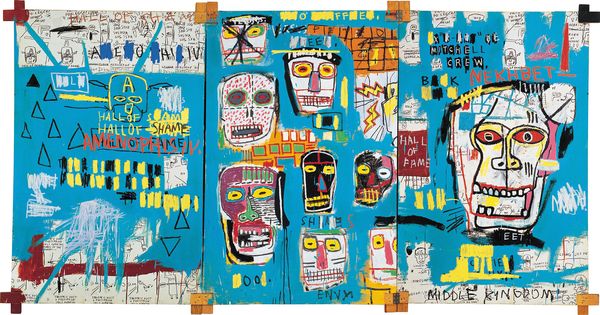
Jean-Michel Basquiat Mitchell Crew, 1983. Acrylic, oilstick and paper collage on canvas mounted on wood supports. Private Collection © The Estate of Jean-Michel Basquiat/ ADAGP, Paris/ARS, New York 2017.
Basquiat continued his interest in depictions of his "crew" when he undertook Untitled (Three Heads) later that year. Having infused a great deal into this work, it must have signaled to the artist that there was a "larger" story to tell. That "story" unfolded a few months later with the realization of Mitchell Crew, a now monumental portrayal of no less than ten heads presented across a pictorial field of almost 12 feet in length. Each head, uniquely rendered, represents a different personage. Each presents an individual whose wide-open eyes and mouth penetrate toward the space of the viewer. As if each is in an act of communication, they invite us to join them in dialogue.
Interestingly, in Untitled (Three Heads), Basquiat's rendering of both eyes and mouth in the larger head to the left share a great deal with the facial features of several of his heads in Mitchell Crew. Because of the similarity of at least two of the heads in Untitled (Three Heads) to Mitchell Crew painted the following year, I would propose that Untitled (Three Heads) was executed in Basquiat's Crosby Street studio sometime after he returned to New York from Los Angeles. Supporting this conclusion is the actual piece of paper on which the work is executed as well as the back of sheet. Unlike many (not all) of Basquiat's works on paper, Untitled (Three Heads) was executed on a thicker sheet of archival paper. In addition, its size is unusual, indicating that it was cut from a larger piece of paper. The back of the work is entirely covered with foot prints and other markings which imply that it was retrieved from the floor of the studio prior to becoming the surface for this artwork. What is suggested is that Basquiat spontaneously chose this particular paper fragment for his continued investigation of the subject of observed individuals. Going further, I would propose that during a visit to Basquiat's New York studio Scott Spiegel came across the multi-head work on paper, and given his familiarity with the works' underlying theme from his earlier acquisition of Six Crimee, sought out this new acquisition of Untitled (Three Heads).
While intimate in scale, Untitled (Three Heads) is rich and complex, demonstrating Basquiat's capacity to present three highly individualized characters, each possessing a unique physical as well as psychological make-up. This work could have only resulted from the artist's capacity to astutely observe and respond to the world around him. These figures are a reflection of what Basquiat learned from his personal experience on the streets of New York.
At the time of his death, Basquiat possessed a large number of his 1982, individualized, single head studies, many of which were exhibited by Robert Miller Gallery in 1990 and shown, displayed in salon style on a single wall. The fact that Basquiat kept so many of these in his personal collection further emphasizes their importance as artistic starting points, faces from which he drew inspiration. The four single head drawings from the Collection of Scott D.F. Spiegel were acquired by Scott when other Basquiat collectors remained focused on his paintings. This further highlights Scott's ability to see the quality and artistic importance of Basquiat’s works on paper.
From the Evening Sale: Jean-Michel Basquiat Untitled. Oil paintstick on paper, executed in 1982.
From the Day Sale: Jean-Michel Basquiat Untitled. Oil paintstick on paper, executed in 1982.
From the Day Sale: Jean-Michel Basquiat Untitled. Oil paintstick on paper, executed in 1982.
From the Day Sale: Jean-Michel Basquiat Untitled. Oil paintstick on paper, executed in 1982.
Basquiat's Transcendental Skull
Basquiat's 1982 image of a cow skull is an anomaly in his oeuvre. Prior to the creation of this work the artist rendered a decomposing cow alongside a standing black figure in Acque Pericolose, 1981. Other early images of the head of a four-legged creature are Television and Cruelty to Animals, 1983 and Roosevelt III, 1983, both of which are more caricature renderings and refer to the friendly creature from the Rocky and Bullwinkle show. Basquiat's 1982 image of a cow skull stands apart, less referential to nature or popular culture, more symbolic and iconic.
Basquiat has rendered his image simply, outlining its generalized shape in black. Contained within the edges of this frontally-defined shape Basquiat animates his facial depiction by means of his unexpected choice of a bright, luminous and inviting blue, accompanied by eyes in a bright red. If Basquiat's choice of colors for his figure departs from physiognomic likeness it implies and inspires viewer engagement. The work's assertive frontality, combined with its luminous coloration, draws the viewer towards its mysterious presence. Having distinguished his image from a recognizable creature, Basquiat's image takes on attributes of a mythic figure, even suggesting that this creature symbolizes another realm, another state of consciousness. In this regard Basquiat's cow skull conveys mythic attributes — akin to some of Picasso's bovine creatures including, Bulls Skull, c. 1942 and Bulls Skull, Fruit and Pitcher, 1939.
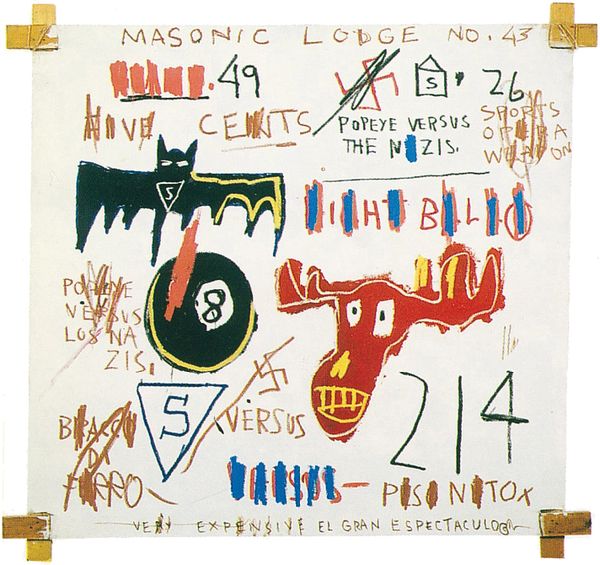
Jean-Michel Basquiat Television and Cruelty to Animals, c. 1983. Acrylic on canvas mounted to tied wood supports, Private Collection © The Estate of Jean-Michel Basquiat/ADAGP, Paris/ARS, New York 2017.
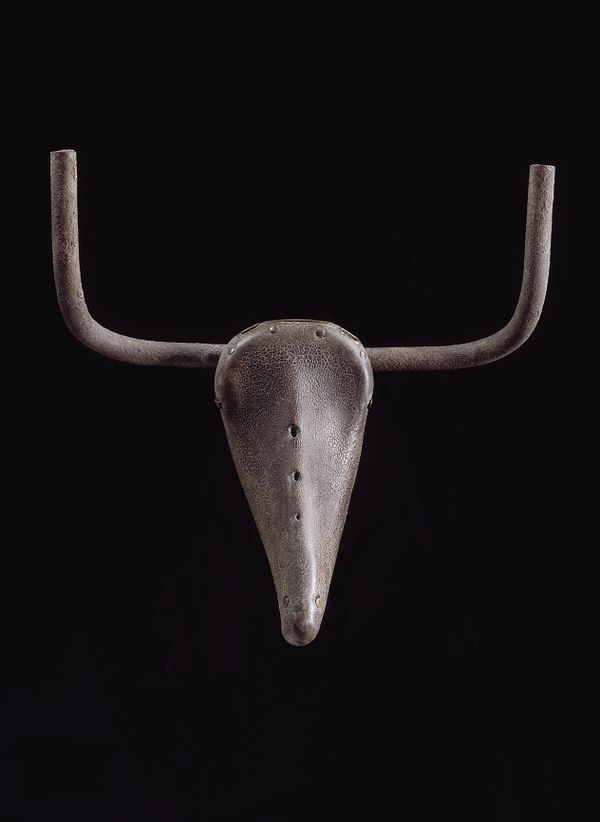
Pablo Picasso Tête de taureau (Bull's Head), 1942. Musée Picasso, Paris © 2017 Estate of Pablo Picasso/Artists Rights Society (ARS), New York.
Basquiat's cow skull feels larger than life. While full of vitality and energy, it exudes something more than a physiological presence. Basquiat’s decision to render this figure in a light-filled blue links the work to atmospheric effects achieved in works such as Untitled (LA Painting), 1982 and Untitled (Black Tar and Feathers), 1982. The deep blue background in both of these works suggests more than a naturalistic atmosphere; it was Basquiat's means of alluding to something beyond our psycho-physical state of being—the transcendental. So too does his choice of coloration for his simple cow skull, a work clearly heralding a higher state of being.
Fred Hoffman, PhD, worked closely with Jean-Michel Basquiat during the artist's residency in Venice, California from 1982-1984, during which time he produced most of the artist's silkscreen editions. Hoffman co-curated the last American Basquiat retrospective in 2005 (Brooklyn Museum, The Museum of Contemporary Art, Los Angeles, Houston Museum of Fine Art). Fred Hoffman is the author of the forthcoming book The Art of Jean-Michel Basquiat (2017, published by Galerie Enrico Navarra Paris and New York).


